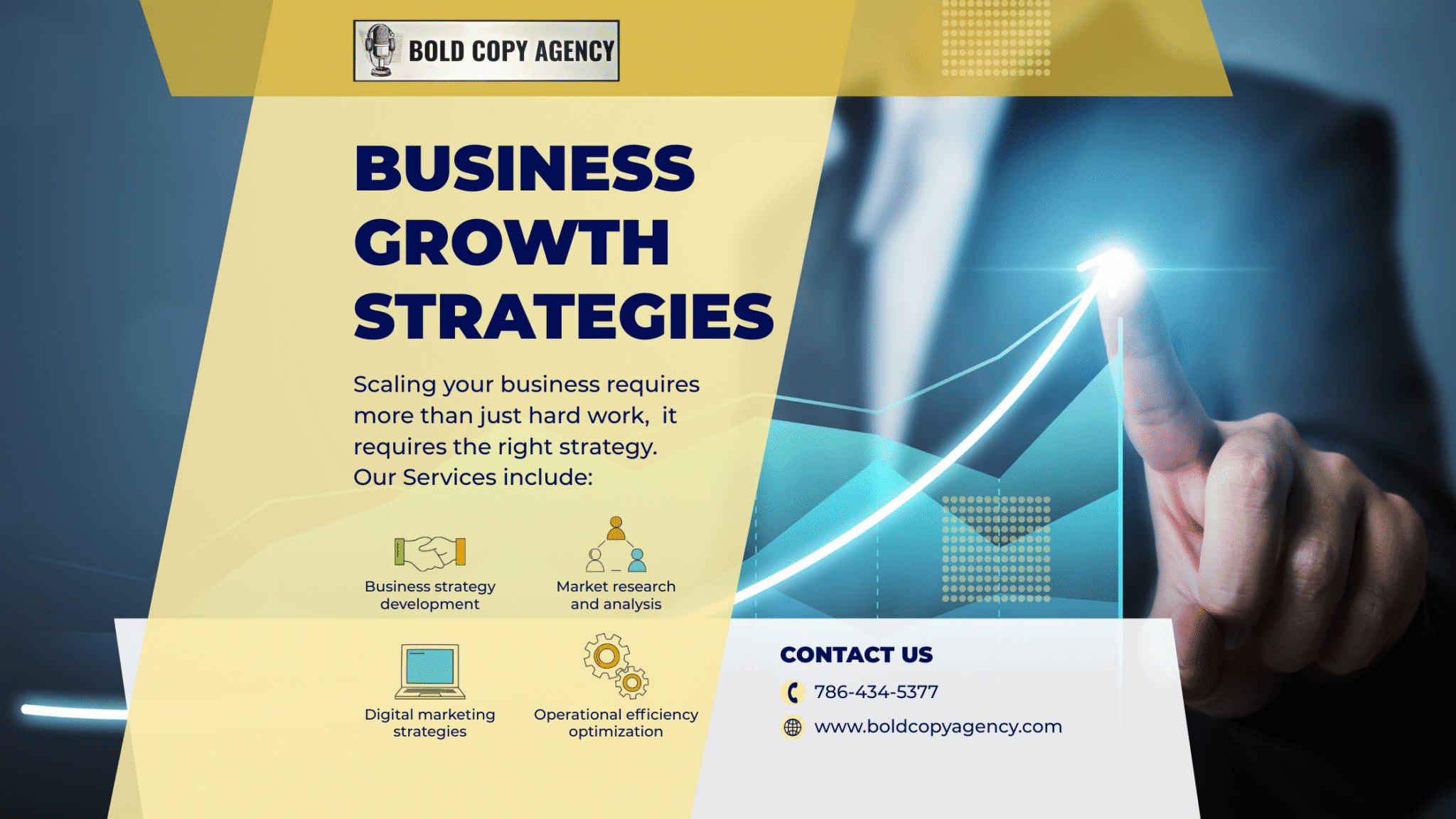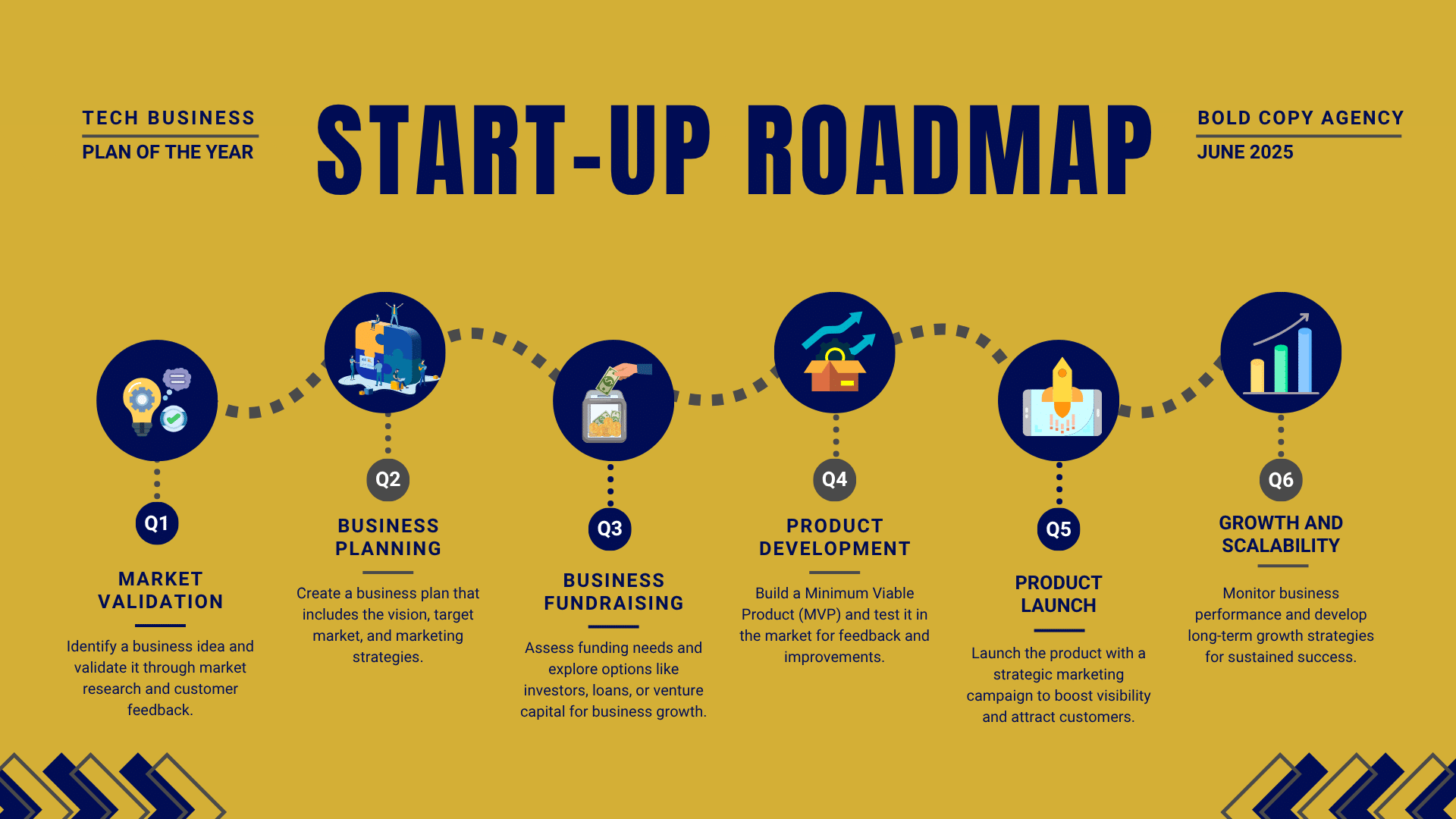
Small Business Growth Strategies That Actually Work
June 28, 2025 by
Russell Otway
GET OUR LATEST WOMEN FOUNDER EQUALITY CHECKLIST
By submitting this form, you are consenting to receive marketing emails from: Bold Copy Agency, LLC. You can revoke your consent to receive emails at any time by using the SafeUnsubscribe® link, found at the bottom of every email. Emails are serviced by Constant Contact
Small Business Growth Strategies That Actually Work (and Make You Laugh)
Plan for Success: Charting Your Course for Small Business Growth
Running a business without a plan is like embarking on a road trip without a map or GPS—you might enjoy the journey, but the chances of reaching your intended destination are slim. In the dynamic world of entrepreneurship, a well-crafted business plan isn’t just a formality; it’s your roadmap to success.
Why Planning Matters
A comprehensive business plan helps you:
-
Set Clear Objectives: Define what success looks like for your business.
-
Allocate Resources Efficiently: Ensure your time, money, and efforts are directed toward activities that drive growth.
-
Anticipate Challenges: Identify potential obstacles and develop strategies to overcome them.
-
Measure Progress: Establish benchmarks to track your business’s development over time.
According to a study by ProfileTree, businesses with detailed plans grow 30% faster than those without. This statistic underscores the importance of strategic planning in achieving small business growth.
Leveraging Internal Resources
At Bold Copy Agency, we understand the nuances of crafting effective business plans. Our Digital Content Strategy Guide offers insights into aligning your content marketing efforts with your overall business objectives. By integrating content strategy into your business plan, you can ensure a cohesive approach to reaching your target audience.
Incorporating Technology
Modern business planning also involves leveraging technology to streamline operations. Tools like BizChat utilize AI to assist small business owners in creating comprehensive plans, even if they lack extensive digital skills. Embracing such tools can enhance your planning process, making it more efficient and effective.
Seeking External Support
Don’t hesitate to seek external assistance when developing your business plan. Organizations like the Small Business Development Centers (SBDCs) and Veteran Business Outreach Centers (VBOCs) offer free consulting services to help you navigate the planning process.
Final Thoughts
Remember, a business plan is a living document. Regularly revisiting and updating your plan ensures it remains aligned with your business’s evolving goals and market conditions. By committing to thorough planning, you’re setting the stage for sustainable growth and long-term success.

Plan for Success: Charting Your Course for Small Business Growth
Running a business without a plan is like going on a road trip with no GPS and a questionable sense of direction. Sure, you might find something interesting along the way, but odds are you’ll burn gas, waste time, and end up in a cornfield wondering where it all went sideways.
If you fail to plan, you plan to fail. Every successful small business growth strategy starts with a clear, actionable roadmap—one that’s tailored to your market, capacity, and vision.
Business planning isn’t just an administrative task; it’s your entrepreneurial blueprint. It keeps you aligned with your goals, guides your team’s focus, and acts as a filter for decisions. According to ProfileTree, companies with a written business plan grow 30% faster than those that wing it. That’s not just theory—that’s execution backed by numbers.
What Goes in a Solid Growth Plan?
Let’s break it down. Your plan should include:
-
Your mission and vision
-
A quick SWOT or competitor analysis
-
A defined ideal customer profile
-
Clear revenue and profit targets
-
Marketing and sales strategies
-
Operational and hiring goals
-
A system for tracking progress monthly and quarterly
Need help outlining your brand message and how it fits into your growth framework? We created a Digital Content Strategy Guide that makes connecting your content plan to your business goals much easier—and yes, it’s free.
You don’t need to write a 50-page manifesto. A crisp, 3–7 page plan that aligns your vision with action steps is more valuable than something bloated and unread.
Make Your Plan Dynamic, Not Dusty
A business plan is a living document. If it hasn’t been updated since you signed your LLC paperwork, it’s time to shake off the cobwebs. Review it at the start of each quarter. Ask yourself:
-
Are we meeting our KPIs?
-
Are we on track with revenue targets?
-
Has the market shifted?
-
What’s working in our marketing, and what’s not?
Use your plan to pivot with intention, not panic.
Also—don’t plan in isolation. If you’re looking to grow, tap into your team, mentors, or external pros for feedback and new perspectives. Better yet, use real customer data to adjust your forecasts and assumptions.
Where to Get Help (Especially for Veterans)
You’re not alone. If you’re a first-time founder or veteran-owned startup, you can get free, expert support through the Small Business Development Centers (SBDC) or Veteran Business Outreach Centers.
They offer one-on-one business counseling, pitch prep, funding assistance, and yes—strategic planning templates you don’t have to build from scratch.
Want help building a brand message that stands out to investors, customers, and clients alike? At Bold Copy Agency, we specialize in business strategy development and digital content that drives measurable growth.
In short: a plan isn’t paperwork—it’s power. It’s your foundation, your focus, and your fallback. If you wouldn’t build a house without a blueprint, don’t try to build a business without one.

Love Your Customers: The Secret Sauce to Business Growth
You might think the key to growing your small business is running after new customers like a door-to-door vacuum salesperson in the ’90s. But here’s the truth: your existing customers are a goldmine that too many entrepreneurs overlook.
And that’s a mistake.
According to Harvard Business Review, it can cost 5 to 25 times more to acquire a new customer than to retain an existing one. Let that sink in. You could spend thousands chasing a cold lead or spend zero dollars keeping a happy customer delighted—and they’ll probably come back, spend more, and bring friends.
So before you pour another chunk of your ad budget into flashy promos for strangers, stop and ask: are you showing your current customers enough love?
Retention Over Acquisition (But Do Both)
This isn’t about ditching new business—it’s about balancing your efforts. Retention is often the faster, more affordable path to steady revenue. Think of your best customers as VIPs. They’ve already bought from you, so you don’t need to convince them you’re legit—they know you deliver.
So how do you keep them?
Start with exceptional customer service. Treat every customer like a first-time guest at your house: welcoming, attentive, and eager to help. Learn their names. Ask how their experience was. Fix issues fast. Consistency is key—your Monday morning service should be just as strong as your Friday afternoon follow-up.
At Bold Copy Agency, we often help clients build email nurture flows and testimonial campaigns specifically for this purpose. If you’re not staying in front of your happy customers, you’re missing opportunities to turn them into ambassadors.
Loyalty Programs That Actually Work
Customer loyalty programs aren’t just a retail gimmick—they’re a proven way to boost purchases and repeat behavior. Monster reports loyalty programs can increase customer purchases by up to 300%. That’s not a typo.
Whether you’re offering a punch card, points system, VIP perks, or just a quarterly thank-you gift, it keeps your business top-of-mind. Bonus points if you add personalization—like a birthday reward or anniversary thank-you email.
And remember: happy customers are also your most powerful (and cheapest) marketing channel. Their referrals convert faster, spend more, and already trust you—because someone they trust told them to.
Listen and Adapt Based on Feedback
Don’t wait until someone’s upset to ask how they feel. Regularly ask for customer feedback. Find out what keeps them coming back and what they wish was better.
Not only does this create connection, it gives you real ideas for improving products or creating upsells. For example, if you own a coffee shop and your regulars rave about your maple oat latte, why not turn that into a retail bag of beans or a subscription club?
You can even use feedback to fuel your content strategy. Positive reviews become social proof on your website, in ads, or on your Google Business profile. Negative feedback? It’s an opportunity to fix something and win back trust—often with more loyalty than before.
In Summary: Be Human, Be Helpful, Be Proactive
Customers don’t leave just because of price—they leave because they feel unappreciated or ignored. You don’t need to throw a parade for every purchase, but you do need to make people feel seen.
When you love your customers, they love you back—and they bring others along for the ride. That’s the kind of small business growth strategy that doesn’t just scale revenue—it builds a loyal tribe.

Spread the Word: Marketing Strategies to Grow Your Small Business
You can’t scale your small business if nobody knows you exist. Period. You could offer the best service, the smartest solution, or the tastiest cupcakes in town—but if you’re the best-kept secret, you’ll stay small. Marketing isn’t about bragging—it’s about making sure the right people know how you solve their problems.
But here’s the good news: you don’t need a massive budget or a full-time team. You just need a plan, a clear message, and consistency.
Start with the Basics: Your Online Home
Let’s start with your website. It doesn’t need to win design awards, but it does need to be fast, mobile-friendly, and clear. When a potential customer lands on your homepage, they should instantly know:
-
What you do
-
Who it’s for
-
How to buy, book, or learn more
If your site doesn’t answer these questions in 5 seconds or less, it’s time for a tune-up.
Also—don’t forget about search engine optimization (SEO). When people Google what you offer, you want to show up, right? Optimize your site with relevant keywords, location data (if applicable), and schema markup. If this sounds overwhelming, start with this Digital Content Strategy Guide we created to simplify the process for small businesses.
Need a full strategy session? Our team at Bold Copy Agency offers copywriting and SEO packages tailored to help service providers and creators climb search rankings without keyword stuffing or clickbait.
Content That Converts (And Doesn’t Feel Salesy)
Once your site is up to speed, it’s time to create content that builds trust. Blog posts, short videos, tutorials, case studies, customer stories—these position you as the go-to expert in your space.
You don’t need to be a professional writer or influencer. You just need to share what you know in a way that helps others. If you’re a CPA, write about common tax mistakes. If you’re a dog groomer, show the tools you use. If you’re a jazz band leader (👀), share behind-the-scenes clips of rehearsals or gigs.
Consistency beats complexity. Don’t overthink it—just show up regularly. Content builds compounding trust.
Embrace Email Marketing
It’s not flashy, but it works: email is still one of the highest ROI channels in all of marketing. Tools like Mailchimp, Flodesk, or Constant Contact make it easy to set up automated sequences, monthly newsletters, or new product announcements.
Start with a lead magnet—like a checklist, free sample, or mini-guide—and encourage site visitors to subscribe. Then, follow up with content that educates, entertains, or solves a problem. Avoid over-promoting. Be human. Be helpful.
Social Media: Pick Your Platform
You don’t need to be on every platform. But you do need to be where your audience hangs out.
If you’re B2B, that might be LinkedIn. If you’re B2C or visual-heavy, that’s probably Instagram, TikTok, or Facebook. Wherever you post, show up with intention. Share value. Start conversations. Respond to comments. And post more of what gets traction.
Pro tip: schedule your content in batches using tools like Buffer, Hootsuite, or Metricool.
And if you’re creating long-form content (like this blog), break it up into bite-sized posts or quotes for social. Repurpose, don’t reinvent.
Don’t Forget Local Visibility
If you have a brick-and-mortar location or serve a local area, Google My Business is your best friend. Optimize your listing with updated hours, service areas, photos, and customer reviews. Nearly 45% of customers who find you online will visit your location in person if your digital presence is strong, according to FitSmallBusiness.
Also consider cross-promotions with complementary local businesses, sponsoring events, or even submitting your story to local media outlets.
TL;DR: Tell the Right People, The Right Way
Marketing isn’t about yelling louder. It’s about speaking clearly and consistently to the people who already need what you offer. Make your message easy to find, impossible to miss, and totally worth sharing.

Want help creating a marketing strategy that actually works for your size and stage? Let’s talk.
Work Smarter: Embracing Tech to Scale Your Business
Working hard is noble. Working smart is profitable. At some point, sheer hustle hits a ceiling. You can only wear so many hats, juggle so many to-dos, and burn the midnight oil for so long. If you want to scale, you need systems—and in 2025, that means leveraging technology for small business growth.
The goal isn’t to replace you. It’s to multiply you.
Automate the Busywork, Elevate the Strategy
Let’s start small. Look at your current daily and weekly tasks. What’s repetitive, manual, and exhausting?
-
Invoicing? Use QuickBooks or Wave.
-
Appointment scheduling? Try Calendly or Acuity.
-
Social media? Automate posts with Hootsuite, Metricool or Buffer.
-
Email follow-up? Set up flows in Mailchimp or Constant Contact.
Once set up, these tools can save you dozens of hours a month—and reduce human error along the way. You’re not outsourcing creativity or personal touch; you’re freeing up bandwidth to apply it more intentionally.
At Bold Copy Agency, we’ve helped clients implement simple automation systems that increased their lead conversion rates and cut admin time by more than half. This isn’t just theory—it’s what we do.
CRM: Your Secret Weapon for Relationship Building
If you’re still tracking leads in a spreadsheet (or worse, not tracking them at all), it’s time to graduate. A CRM (Customer Relationship Management) tool like HubSpot, Pipedrive, or Zoho helps you:
-
Capture leads automatically
-
Track sales stages
-
Send follow-up emails
-
Assign team tasks
-
Analyze deal conversions
It keeps everything organized so no potential client slips through the cracks. Think of it as your digital memory and sales coach all in one.
Project Management = Peace of Mind
As your team grows—or your freelance plate gets fuller—keeping track of everything in your head isn’t sustainable. Use tools like Trello, Asana, or ClickUp to assign tasks, set deadlines, and keep momentum moving.
Project management tools make collaboration seamless and reduce micromanagement. Everyone knows what’s due, who’s doing it, and where the project stands.
Pro tip: Combine your project dashboard with automation (like Zapier or Make.com) to connect tasks between platforms and reduce double-entry.
E-Commerce and Online Booking Tools
If you sell products, services, or consultations, give customers a way to buy or book without emailing you first. Platforms like Shopify, Squarespace, or WooCommerce make online sales easy. And tools like Calendly + Stripe let you get paid when appointments are scheduled—no chasing invoices.
We cover this in more detail inside our Digital Content Strategy Guide, especially if you’re mapping a digital funnel from awareness to conversion.
Why Tech Helps You Survive Downturns
According to Monster, small businesses that adopt digital tools and automation systems are far more likely to survive economic downturns. Why? Because they’re leaner, faster, and more responsive.
If COVID taught entrepreneurs anything, it’s this: you need to be agile. Tech gives you agility.
Final Thought: Start Simple, Scale Smart
You don’t have to become a tech guru overnight. Start with one tool to solve your biggest current bottleneck. Once you see the benefit, stack another one. Over time, you’ll create a tech-powered ecosystem that helps your business grow—without growing your stress.
And if you’re not sure where to begin, reach out to us at Bold Copy Agency. We’re happy to help map your tech stack to your growth goals.

You Can’t Do It All: Build a Team to Grow Your Business
Ever seen a one-person band? Cymbals between the knees, guitar on the back, harmonica at the lips. It’s impressive for a street performance—but not sustainable for a business. If you want real small business growth, you have to stop doing everything yourself.
Solopreneur pride is real—and it’s often the first bottleneck that chokes your business’s potential. Eventually, the very skills that helped you launch will hold you back from scaling.
Here’s the truth: no one builds something scalable and sustainable alone. Not even Batman—he had Alfred, Lucius Fox, and a whole tech team. Let’s build yours.
Start by Identifying What Only You Can Do
Before you build your team, look in the mirror. What’s your zone of genius? What’s the thing no one else can do like you?
Now write down everything else you’re currently doing that:
-
You don’t love
-
You’re not great at
-
Or eats your time without growing revenue
That’s your “outsource list.” And it’s the foundation of a smarter, more scalable business structure.
You Don’t Have to Hire Full-Time Right Away
Hiring a full-time employee can feel like a big leap. So don’t take it yet. Start by outsourcing low-risk, high-impact tasks to:
-
Freelancers (design, copywriting, tech)
-
Virtual assistants (admin, inbox, scheduling)
-
Contractors (sales, marketing, finance)
You can find vetted talent on platforms like Upwork, FreeUp, or MarketerHire. Or you can build relationships in niche Facebook groups or LinkedIn communities in your industry.
This lets you scale workload without inflating your overhead.
If you’re not sure which roles to fill first, our services page breaks down how we support small teams who need to grow faster without full-time commitments.
Build Systems, Not Just a Roster
Hiring is only half the job. If your processes live in your head, your team can’t scale with you. Start documenting everything from how you onboard clients to how you send invoices.
Use SOPs (standard operating procedures), video walkthroughs, and shared docs. Tools like Notion, Loom, or Google Drive work perfectly for small teams.
These systems do three magical things:
-
Speed up training
-
Improve consistency
-
Let you delegate with confidence
This isn’t just about freedom—it’s about quality control and long-term growth.
Invest in Culture (Even if You’re Small)
You don’t need ping pong tables or corporate retreats to build culture. But you do need values, clarity, and communication.
Make sure every contractor, VA, or freelancer knows:
-
Your mission
-
Your standards
-
Your expectations
-
And where they fit into your long-term vision
A team aligned with your values becomes a force multiplier.
And yes, give shout-outs and bonuses when people crush it. Happy teams build happy brands.
The Numbers Back It Up
According to Monster, the right hires can directly fuel small business expansion. The key word is right—don’t just hire reactively, hire strategically.
A skilled contractor can unlock capacity you didn’t know you had. A strong hire can double your productivity and halve your stress.
You’re the CEO—Act Like It
You’re not just a service provider, maker, or marketer anymore. You’re the visionary. The leader. The person responsible for building something bigger than yourself.
Let go of the guilt. Let go of the perfectionism. Start building a support system that matches the size of your ambition.

If you’re ready to grow your team, your systems, and your brand messaging at the same time, let’s chat. You don’t have to go it alone anymore.
🔵 Schedule Your Free Growth Strategy Call
📚 Sources
-
Monster – 5 Strategies for Small Business Growth
A trusted business resource outlining key areas of small business growth, including hiring, retention, marketing, and technology adoption. -
ProfileTree – The Impact of Business Planning on Strategic Growth
A data-backed article exploring why businesses with written plans grow faster, and how to structure your strategy for long-term success. -
Harvard Business Review – The Value of Keeping the Right Customers
An authoritative breakdown on the cost of customer acquisition vs. retention and how long-term customer loyalty increases profitability. -
SBA – Veteran Business Outreach Center (VBOC) Program
Official Small Business Administration resource for veterans, providing mentorship, business plan development, and funding support. -
America’s SBDC – Find Your Local Small Business Development Center
A nationwide support network offering free consulting for business planning, marketing, funding, and growth strategy implementation. -
FitSmallBusiness – 21 Digital Marketing Statistics for Small Businesses
An in-depth data compilation that supports the ROI of digital marketing, including SEO, social media, and website optimization.
Russell Otway is the driving force behind Bold Copy Agency, a bespoke content creation service specializing in the music industry. With over a decade of experience in copywriting and a deep passion for music, Russell has carved out a niche for himself as the go-to expert for artists, labels, and music professionals seeking to elevate their brand with compelling narratives.
Having worked with a broad spectrum of clients from up-and-coming musicians to established industry giants, Russell’s expertise lies in crafting narratives that resonate with audiences and amplify an artist’s presence in a crowded market. His work is characterized by a blend of creativity, industry insight, and a keen understanding of digital marketing trends, ensuring that his clients not only stand out but also achieve their marketing objectives.
A firm believer in the power of storytelling to connect and inspire, Russell continuously explores new and innovative ways to bring music stories to life. When he’s not weaving compelling artist biographies or dynamic press releases, he can be found sharing his insights at industry conferences or contributing to leading music and marketing publications. Russell’s mission with Bold Copy Agency is simple: to help music professionals tell their stories in the most impactful way possible, unlocking their full potential and propelling their careers to new heights.
